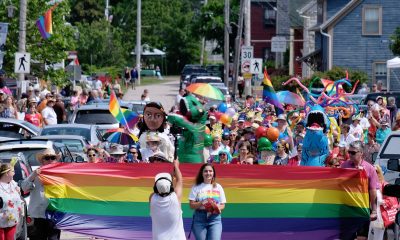Living
Castro catastrophe
‘We Were Here’ offers first-hand accounts of AIDS horrors in San Francisco
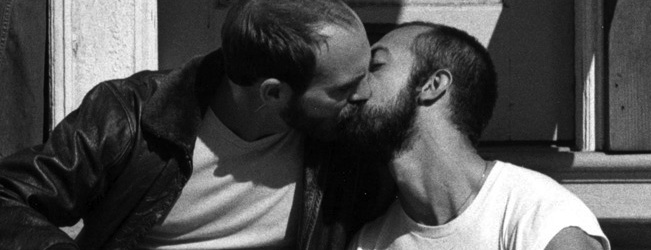
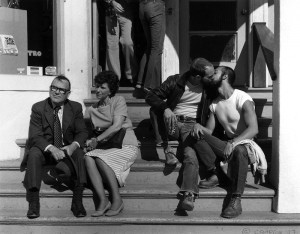
A vintage still from San Francisco's Castro neighborhood used in 'We Were Here.' (Photo courtesy of Film Collaborative)
There were angels in San Francisco.
But unlike in Tony Kushner’s two-part Pulitzer-Prize-winning play about AIDS — “Angels in America,” set in New York City in the mid-1980s — these angels were real people.
In the Kushner play, an angel descends to earth, as his fictional characters struggled with this unsettling new disease, the “gay cancer” as it was being called, an epidemic that seemed to spring from nowhere and then spread like a wicked wildfire.
In San Francisco it also struck like a bolt from the blue and purple unknown, its stigmata the purple-ish and dark reddish-blue marks of skin lesions — those herpes-like, cancerous tumors of Kaposi’s sarcoma — that began to dot faces and limbs and torsos with an ugliness that was unmistakable and the cause unknown. Right-wing televangelist Jerry Falwell called the lesions, which were seen as the defining illnesses of AIDS in the 1980s, to be the signs of Satan’s claim over sins of the flesh and God’s punishment for those same-sex sins, demons of a heaven-sent plague upon homosexuality.
“For a group of gay men, so into physical appearance, this was a disease whose very physical manifestations were horrifying,” says Daniel, one of the five people profiled in a new and deeply affecting documentary film, “We Were Here,” a gut-punch of a feature-length film by producer-director David Weissman, about the coming of AIDS to the Bay Area, and the human havoc it wrought.
This film is truly a moving picture. Co-presented with Reel Affirmations, as part of the 25th Annual FilmFest D.C. (now through April 17), it is playing tonight and Saturday night at the Regal Cinemas Gallery Place, on 7th Street, N.W., near Verizon Center. Each showing is at 6:30 p.m. followed by town meetings to discuss the film and its ramifications today in D.C. where the disease still flourishes.
Each one of the five in “We Were Here” is a witness, a survivor, and haunted in some indelible way by what they saw. Four of them are gay men (Daniel, Ed, Guy and Paul), who each contracted HIV yet somehow survived. One is a straight woman (Eileen) who ministered to the patients, as a nurse who cared about them as human beings, not clinical case studies.
Like Eileen, who appears to be a modern-day Florence Nightingale, each one is an angel, each able to say, “we were here.” Each is a survivor of the mysterious epidemic that moved through San Francisco in the 1980s with all the ferocity of an avenging angel, a grim reaper carrying off those who had sown such pleasure, but now so many of them faced death as a result.
Each is an eyewitness. At the skillful hand of filmmaker Weissman, who also earlier produced “The Cockettes,” a documentary about the campier side of the Bay Area, the testimony of the five is heartfelt and eloquent, bringing the kind of emotion that only those who experienced it first hand can bring.
Daniel’s voice is such an example. His voice is riveting, his gaze impossible to turn away from. He’s a modern-day Ancient Mariner come to tell us of how wrong things can get when bad things happen to good people.
He recalls that tragic time when no one could comprehend what was happening, as the virus burned its way through the carefree, almost heedless hedonism that came to the Bay Area after Stonewall in 1969, when hippies flocked to the Haight Ashbury and gays to the Castro. For a time all was well. But it was the sexual romp before the gathering storm.
Paul, who found his early calling in political action working with Harvey Milk, says, “I came to San Francisco with nothing but my backpack and my boyfriend.” He recalls that in the mid-1970s, “I believed that at that time in San Francisco there were nothing but crazy dreamers.”
Daniel went, recalling that, “I always wanted to meet a blond surfer but I was still in the closet, but then I came out with a bang,” in part spurred by being cast in the gay-themed play “The Boys in the Band.”
One observer, appearing in the film, puts it bluntly about that era: “If you took a lot of young gay men and asked them, ‘How much sex would you like to have?,’ the answer was, ‘A lot,’ and the sense was, sex is good, and more sex is good,” and after all, he adds, “We came to San Francisco to be gay.” Ed, who moved to the city in 1981, is equally blunt: “I was always in relationships, but they were open … My sexual outlet was always the bath houses and it was fun.”
But times were changing. In 1979, Harvey Milk was assassinated. In 1980, Ronald Reagan was elected president. The hopes and dreams of hippie hedonism didn’t last. But then, says Weissman, who documents it with clinical detail from archival footage, signs of trouble began to appear.
“People were wasting, losing so much weight, [San Francisco’s Castro neighborhood] looked like a concentration camp,” says Daniel. “You almost had to turn away, it was just too scary.” He felt haggard and haunted: “I was losing all the fat in my face and my butt — I would walk by a store window and jump, ‘Who was that?’ — I was skin and bones.”
At times death came with startling swiftness. Eileen, who chose to care for AIDS sufferers and then to work on clinical trials seeking pharmaceutical relief of the worst symptoms, says that in the hospital where she worked, “People were coming in with a KS lesion one day and were dead 10 days later.” Her own heart went out to them, but others shrank away in fear and ignorance, as some voices were raised calling for tattoos to be stenciled onto all persons diagnosed with HIV and some even called for packing them away into leper-like colonies.
“From the beginning,” she says, “I just couldn’t understand the homophobia that was going on and the fear of going into the [hospital] rooms.”
“There was nothing that unusual in that people are of course going to die,” says Ed, who speaks like a creative writer, a craft in which he earned a graduate degree. But in San Francisco, he says, “It’s just that it happened in a targeted community, to people who were disenfranchised, separated from their families.” But then a kind of miracle happened when people like Eileen stepped forward, as well as gay men who were not infected. In Ed’s words, “A whole different group of people stepped up and became their families.”
They got involved. Eileen joined ACT UP. Daniel fought his way back from depression and worked on the Names Project, which made the AIDS quilt.
Each of five was chosen, says Weissman, because they had a special story to tell, and the film delivers what they have to say with an emotional wallop. But more than that, he admits, “The city is also a character” in the film, which he calls “Very personal to me” and “a love letter to San Francisco,” where after some years living in Portland, Ore., he is now based. A commercial release is planned for later in the year.
Weissman, who is gay, was born in 1954 in Los Angeles, and never went to college, he explains, because he “lived through the hippie times.” He got into filmmaking in his late 20s. He says it was “something on the spur of the moment.” He took coursework at the City College of San Francisco, but says at first he never thought of himself as a documentarian. Instead, he produced a series of short comedies until finally, after “a moment of unexpected inspiration,” he made the 2001 acclaimed documentary, “The Cockettes,” about the Bay Area’s legendary theater troupe of hippies and drag queens.
“Some people worry that seeing a film like this will be a downer,” Weissman says. “But that’s definitely not the case. Instead, it’s a cathartic experience, healing and empowering.”
“Especially for young gay men today, who don’t know very much about our history,” Weissman says the film opens “a window about how we got where we are today, and the resilience our community has shown in the face of terrible adversity.”
Other gay-themed films slated for fest
The Washington, D.C. 25th annual international film festival event comes alive this week overflowing the Historic Lincoln Theatre on U Street, AMC Mazza Gallerie, Regal Gallery Place at Verizon Center on 7th Street N.W., the Landmark E Street Cinemas, the Avalon and other venues through April 17.
“We know for sure that people in D.C. are interested in films other than Hollywood films,” says Tony Gittens, who founded the festival in 1987.
Themes include “Justice Matters,” a cluster of films focusing on social justice issues; Global Rhythms, a special section of music films; Short Cuts, eight films less than feature length from around the world; and “Lunafest,” nearly 90 minutes of short films for, by and about women. Tickets for most films are $11, he says, and shows tend to sell out, so buying tickets online is the smart bet.
For a complete list of films and events, which include “freebies” for children and seniors, and to purchase tickets, visit filmfestdc.org or call 888-996-4774 from 10 a.m.-6 p.m. Monday through Friday and from noon-5 p.m. on weekends. Tickets may also be purchased at the theater on the day of the show, with the box office opening one hour before the venue’s first screening of the day.
In addition to “We Were Here,” three others have LGBT appeal:
“Circumstance” (“Sharayet”) in Persian with English subtitles 9 p.m. tonight and 6 p.m. Saturday at Regal Cinemas Gallery Place. Directed by Maryam Keshavasrz, this joint French-Iranian-USA production won this year’s Sundance Film Festival audience award. A young Iranian girl, still in her teens, Atafeh, and her best friend Shireen, experiment with mutual sexual attraction amid the subculture of Tehran’s underground art scene and face familial disapproval.
“For 80 Days” (“80 egunean”) in Spanish with English subtitles co-presented with the Embassy of Spain at 7:30 p.m. Sunday and 8:30 p.m. Monday at the Avalon Theatre, 5612 Connecticut Ave. N.W. Directed by Jon Garano and Jose Maria Goenaga, this Spanish entry depicts two women, one of them lesbian, who were best friends in youth, who meet again by accident 50 years later.
“Loose Cannons” (“Mine Vaganti”) in Italian with English subtitles screens at 9 p.m. tonight and 7 p.m. Saturday at AMC Mazza Gallery, 5300 Wisconsin Ave. N.W.
Directed by Ferzan Ozpetek, the films depicts a large, eccentric family whose patriarch puts pressure on the two sons, who are gay, to follow in the family business.
Real Estate
Celebrate the power of homeownership this Fourth of July
Owning a home is powerful act of self-determination

This Fourth of July, celebrate more than independence: celebrate the power of LGBTQ+ homeownership. Explore resources, rights, and representation with GayRealEstate.com, the trusted leader in LGBTQ+ real estate for over 30 years.
Home is more than a house: it’s a symbol of freedom
As the fireworks light up the sky this Fourth of July, LGBTQ+ individuals and families across the country are not just celebrating the nation’s independence — they’re celebrating personal milestones of freedom, visibility, and the right to call a place their own.
For many in the LGBTQ+ community, owning a home represents more than stability — it’s a powerful act of self-determination. After generations of discrimination and exclusion from housing opportunities, more LGBTQ+ people are stepping into homeownership with pride and purpose.
Why homeownership matters to the LGBTQ+ community
While progress has been made, LGBTQ+ homebuyers still face unique challenges, including:
- Housing discrimination, even in states with legal protections
- Limited access to LGBTQ+ friendly realtors and resources
- Concerns about safety and acceptance in new neighborhoods
- Lack of representation in the real estate industry
That’s why the Fourth of July is a perfect time to reflect not just on freedom as a concept, but on how that freedom is expressed in the real world — through ownership, safety, and pride in where and how we live.
Finding LGBTQ+ Friendly Neighborhoods
One of the top concerns for LGBTQ+ buyers is whether they’ll feel safe, accepted, and welcome in their new neighborhood. Thanks to evolving attitudes and stronger community support, many cities across the U.S. now offer inclusive, affirming environments.
Some of the best cities for LGBTQ+ home buyers include:
- Wilton Manors, Fla. – A vibrant LGBTQ+ hub with strong community ties
- Palm Springs, Calif. – A longtime favorite for LGBTQ+ homeowners
- Asheville, N.C. – Progressive and artsy, with growing LGBTQ+ visibility
- Portland, Ore. – Inclusive, eco-conscious, and diverse
- Philadelphia, PA – Rich in history and LGBTQ+ community leadership
When you work with an LGBTQ+ friendly realtor, you get insight into more than property values — you get a real perspective on where you’ll feel most at home.
Navigating the real estate process with confidence
Whether you’re a first-time gay homebuyer or preparing to sell your home as an LGBTQ+ couple, it’s essential to understand your rights and options. Here are a few key tips:
1. Work with a trusted LGBTQ+ real estate agent
Representation matters. A gay realtor, lesbian real estate agent, or LGBTQ+ friendly agent understands the unique concerns you may face and advocates for you every step of the way.
Use GayRealEstate.com to connect with LGBTQ+ real estate agents near you. For over 30 years, we’ve helped LGBTQ+ buyers and sellers find their ideal home and a professional who respects their identity.
2. Know your legal protections
While federal law (via the Fair Housing Act and Supreme Court rulings) prohibits housing discrimination based on sexual orientation or gender identity, enforcement can vary by state. Make sure to research:
- State-level housing discrimination laws
- Local LGBTQ+ protections and resources
- What to do if you experience discrimination during a transaction
3. Secure inclusive financing
While most lenders follow fair lending rules, it’s smart to seek out banks or credit unions with LGBTQ+ inclusive policies and a history of non-discriminatory lending practices.
4. Plan for the future as a family
For same-sex couples, especially unmarried partners, it’s vital to review how you’ll hold the title, designate beneficiaries, and plan your estate.
Ask your agent or attorney about:
- Joint tenancy with right of survivorship
- Living trusts
- Powers of attorney and healthcare proxies
Selling a home as an LGBTQ+ homeowner
If you’re listing your home, working with a gay-friendly real estate agent ensures your identity and story are honored — not hidden — in the process.
Highlight:
- Your community connections
- Your home’s role in creating a safe space
- Local LGBTQ+ resources to attract like-minded buyers
Showcasing the full value of your home includes sharing what it meant to live there authentically and safely.
Your home, your freedom
The Fourth of July reminds us that freedom isn’t just an abstract idea — it’s lived every day in the spaces where we find comfort, love, and belonging. For the LGBTQ+ community, the right to own and thrive in a home is part of the larger journey toward full equality.
At GayRealEstate.com, we believe every LGBTQ+ person deserves:
- A safe place to live
- A community that welcomes them
- An advocate in the home buying or selling process
Ready to make a move?
Whether you’re dreaming of your first home, upgrading with your partner, or selling a space that helped shape your identity, GayRealEstate.com is your trusted partner. With our nationwide network of gay realtors, lesbian real estate agents, and LGBTQ+ friendly professionals, we make your journey smooth, respectful, and informed.
Visit GayRealEstate.com to:
- Search LGBTQ+ friendly homes
- Connect with inclusive real estate agents
- Access free guides for buyers and sellers
- Protect your rights and get expert advice
This Fourth of July, celebrate more than independence — celebrate your freedom to live, love, and own with pride.

Did you melt like the Wicked Witch of the West this week?
As summer temperatures rise, keeping your home or apartment cool during a heat wave can become both a comfort issue and a financial challenge. One of the most effective ways to keep a home cool is to prevent heat from entering in the first place. Sunlight streaming through windows can significantly raise indoor temperatures. Consider the following solutions:
• Close blinds or curtains during the hottest parts of the day. Blackout curtains or thermal drapes can reduce heat gain by up to 30%.
• Install reflective window films to block UV rays and reduce solar heat without sacrificing natural light.
• Use outdoor shading solutions such as awnings (yes, the ones you removed because they were “dated”) and shutters to limit direct sunlight.
Fans are a cost-effective way to circulate air and create a wind-chill effect that makes rooms feel cooler.
• Ceiling fans should rotate counterclockwise in the summer to push cool air down.
• Box fans or oscillating fans can be placed near windows to pull in cooler evening air or push hot air out.
• Create a cross-breeze by opening windows on opposite sides of your home and positioning fans to direct airflow through the space.
• For an extra cooling effect, place a bowl of ice or a frozen water bottle in front of a fan to circulate chilled air.
To optimize natural ventilation, open windows early in the morning or late in the evening when outdoor temperatures drop. This allows cooler air to flow in and helps ventilate heat that built up during the day.
Appliances and electronics generate a surprising amount of heat. To reduce indoor temperatures:
• Avoid using the oven or stove during the day; opt for no-cook meals, microwave cooking, or grilling outside.
• Run heat-producing appliances like dishwashers and clothes dryers in the early morning or late evening.
• Unplug electronics when not in use, as even standby power can add heat to your space.
• Switching to energy-efficient LED lightbulbs can also reduce ambient heat compared to incandescent lighting.
If you do use an air conditioner, maximize its effectiveness by:
• Setting it to a reasonable temperature—around 76–78°F when you’re home and higher when you’re away.
• Cleaning or replacing filters regularly to maintain airflow and efficiency.
• Sealing gaps around doors and windows to prevent cool air from escaping. (Didn’t we all have a parent who said, “Close the door. You’re letting all the cool out?”)
• Using a programmable thermostat to optimize cooling schedules and reduce energy use.
If it is not cost-prohibitive, adding insulation in attics and walls can greatly reduce heat transfer. Solar panels that reflect heat can also help, as well as offset the cost of their installation. Adding weatherstripping around doors and windows, sealing cracks, and using door sweeps can make a significant difference in keeping heat out and cool air in.
Natural and eco-conscious methods can also help cool your home.
• Snake plants, ferns, or rubber trees can improve air quality and slightly cool the air through transpiration.
• White or reflective roof paint can reduce roof temperatures significantly.
• Cooling mats or bedding can make sleeping more comfortable without cranking up the A/C.
For renters or those who can’t make permanent modifications, there are still plenty of ways to keep cool.
• Use portable fans and A/C units instead of built-in systems, making sure they are the correct size for your space.
• Removable window film or static cling tinting can reflect heat without violating your lease.
• Install tension rod curtains or temporary blackout panels instead of hardware-mounted window coverings.
• Add draft blockers and weatherstripping tape that can be applied and removed without damage.
• Cover floors with light-colored rugs to reflect heat rather than absorb it.
• If allowed, use temporary adhesive hooks to hang reflective materials or light-filtering fabrics over windows.
Even if your space is warm, you can still take steps to help your body stay cool.
• Wear light, breathable fabrics like cotton or linen.
• Stay hydrated and avoid caffeine or alcohol during peak heat hours.
• Take cool showers or use damp cloths on your neck and wrists to bring your body temperature down.
Keeping your home or apartment cool in the summer doesn’t have to be expensive or energy-intensive. With a few adjustments such as blocking sunlight, optimizing airflow, using fans effectively, and making renter-friendly upgrades, you can create a more comfortable indoor environment while keeping energy bills in check.
Valerie M. Blake is a licensed Associate Broker in D.C., Maryland, and Virginia with RLAH @properties. Call or text her at 202-246-8602, email her at DCHomeQuest.com, or follow her on Facebook at TheRealst8ofAffairs.
Real Estate
The world’s on fire and D.C. is on sale (sort of)
Prices are up, but then again, nothing makes sense anymore
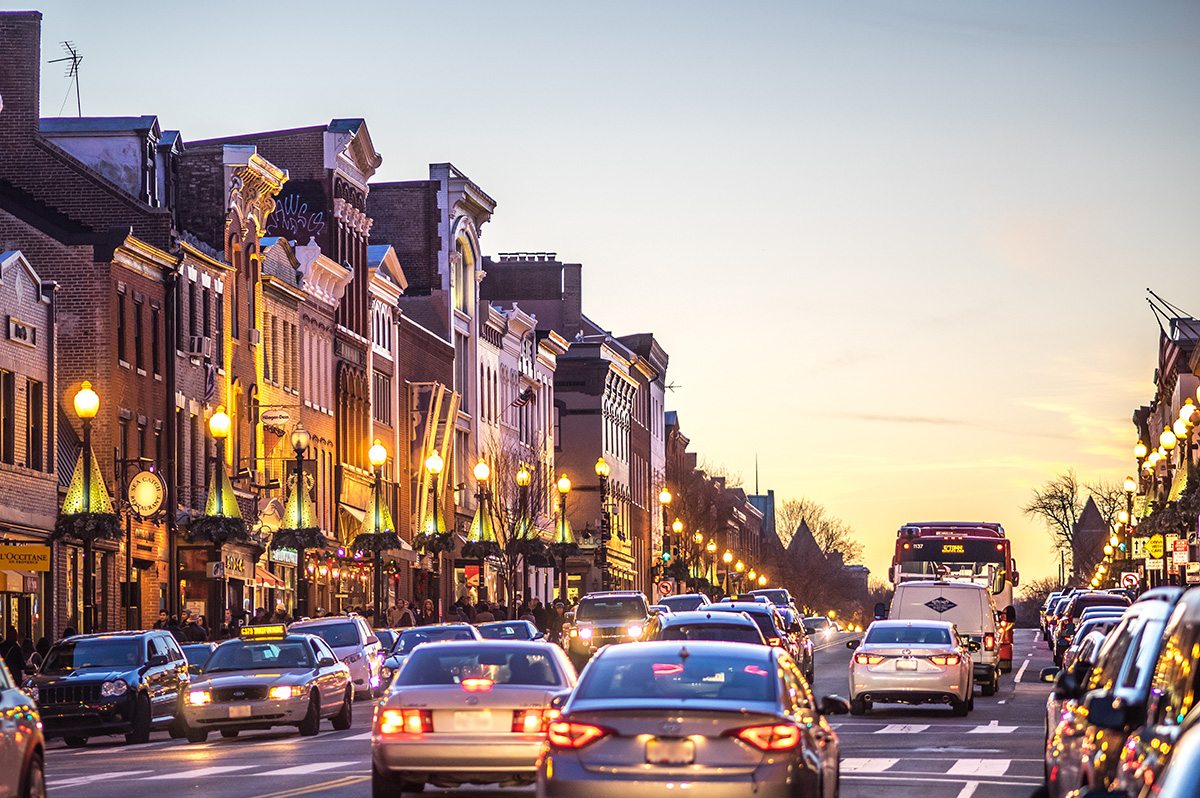
ICE is disappearing people, revered government agencies are shuttering, and who knows if we’ll be in World War III next week? But can you believe prices in D.C. are actually still up 6.3% since last year? It doesn’t make sense, and perhaps that does make sense, because nothing seems to make any sense any more.
That said, there are some parts of our market that are truly suffering. The interest rates, which have been up, up, up for about four years now, are the ongoing rain on our market’s military parade. Combine that with 75,000 federal employees taking a buyout nationwide, and DOGE cuts eliminating around 40,000 federal jobs in the District (per estimates by the D.C. CFO), not to mention thousands of other job losses in non-governmental organizations due to funding and program cuts, and you’ve got a case of uncertainty, and downright unaffordability in the pool of otherwise would-be buyers.
This has had a marked impact on properties that starter-home buyers and low- to mid-level employees would otherwise buy, most notably condominium and cooperative apartment units. These properties have already slowed in our market thanks to the profound impact that higher interest rates have had on their monthly carrying costs—pair that with job insecurity, and a lot of condos are proving to be very difficult to sell indeed.
So how is the average sale price up in our market?
The increase is almost entirely due to the resounding strength of the single-family home market, especially in upper Northwest D.C., where it is still quite common to see bidding wars, even on properties pushing past the $3M mark. It seems that buyers in that echelon are less impacted by a few percentage points in the interest rate, and less concerned about their job security. Notably, those buyers are often married with children and have an absolute need for more space, must stay in the area due to one spouse’s job, or the kid’s friend group, regardless of whether the cost of owning is thousands of dollars more per month than it would have been in 2020 or 2021. The continued appreciation in these neighborhoods defies imagination.
So, what to do if you are not one of those lucky enough to be shopping for a $3M home? The short answer: wait. If you want more space, rent your current place out and learn the joys of being a landlord while someone else pays your mortgage. Need the equity from your current home to buy your next place? Get a home equity line of credit, or loan, and pull the equity out of your current place to buy the next one. Or—and I have never recommended this before in 21 years of being a Realtor—rent for a few years. Sure, I’d love to list and sell your condo so you can climb the real estate ladder, but it might just be a waste of time, money or both if you could just ride out this storm and sell in a DOGE-less future.
All this said, there are some condos that seem to be immune from this recent negative news. Anecdotally, it feels like it’s the truly special ones that do just fine no matter the market. Our recent listing in Capitol Hill had a view from every one of its 15 windows of the Supreme Court. Sold in five days with six offers. Another condo was on the top two floors of a townhouse and had the coolest black wood floors that gleamed like a grand piano. Sold in four days at full price.
So, all is not for naught if you have a condo or home in an area that people want to be in, with nice space, light, amenities and a certain je ne sais quois. And, as long as we have a democracy in a few years, my experience says our market will be back, stronger than ever, really soon.
David Bediz is a Realtor and mortgage loan broker for the Bediz Group LLC and Home Starts Here, LLC. Reach him at [email protected].
-

 U.S. Supreme Court3 days ago
U.S. Supreme Court3 days agoSupreme Court to consider bans on trans athletes in school sports
-

 Out & About3 days ago
Out & About3 days agoCelebrate the Fourth of July the gay way!
-

 Virginia3 days ago
Virginia3 days agoVa. court allows conversion therapy despite law banning it
-
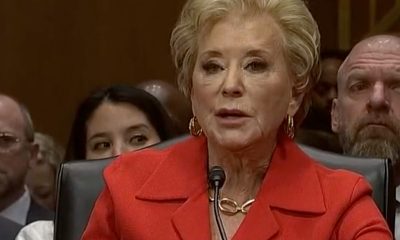
 Federal Government5 days ago
Federal Government5 days agoUPenn erases Lia Thomas’s records as part of settlement with White House





